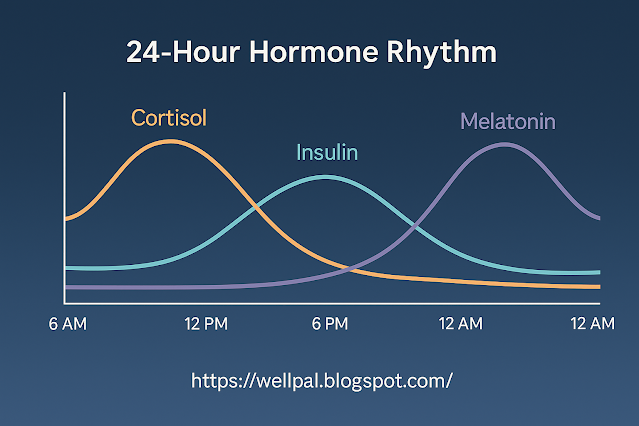- Get link
- X
- Other Apps
- Get link
- X
- Other Apps
Your hormones ride daily waves. Align light, meals, movement, and sleep timing to boost energy, metabolism, and clarity.

⚡ TL;DR — 3 Lines
- Your hormones operate on a 24-hour rhythm.
- Aligning habits with hormone timing boosts energy, metabolism, and clarity.
- Mistiming meals, workouts, or light → fatigue and imbalance.
🧠 Expert Dialogue: “When You Do Things Matters — Not Just What You Do”
Emma (Overwhelmed Entrepreneur): “I’ve started eating cleaner and exercising more, but I still feel tired and anxious.”
Dr. Javier Lin (Chronobiologist): “Great start — but timing is the missing piece. Sunrise breakfast or midnight gym?”
Emma: “Skipping breakfast and gym after Netflix… at 12 a.m.”
Dr. Lin: “That desynchronizes hormones. Morning cortisol should fuel focus; melatonin should rise at night. Late meals and late workouts confuse the clock.”
🔬 The Science of Hormone Timing
1) Morning Cortisol Surge
Cortisol naturally peaks ~6–8 a.m. Morning light and a balanced breakfast reinforce this curve.
2) Midday Metabolic Efficiency
Insulin sensitivity and digestive strength are generally highest between 10 a.m. and 2 p.m. — a smart window for your largest meal.
3) Evening Melatonin Rise
Blue light after sunset delays melatonin release, fragmenting sleep and downstream hormonal cycles.
Notes: Findings across chronobiology literature (Cell Reports, JCEM, Nature Communications) indicate endocrine rhythms respond to light, feeding, and activity timing.
✨ Experience Story: From Fog to Flow
I ran on 2 p.m. lattes and 11 p.m. brainstorms until burnout hit. After learning cortisol curves, I swapped phone scrolling for morning walks and ate lunch by noon. Within weeks, sleep deepened, cravings fell, and creativity surged by 10 a.m.

🧪 Self-Check: Is Your Hormonal Clock Misaligned?
Tick all that apply. A brief 2-second interstitial appears before results. Educational—not medical advice.
0/10 selected
⏳ Preparing your personalized plan… (2s)
📊 Quick Poll — When Do You Feel Most Energized?
📈 Poll Results (Sample)
0 votes
🌅 Morning
☀️ Midday
🌤 Afternoon
🌇 Evening
🌙 Night
❓ FAQ — Hormone Timing Explained
1) Is hormone timing only important for women?
No. While cycles differ, all adults benefit from aligning with circadian hormonal rhythms.
2) Does eating late really affect hormones?
Yes. Late meals can disrupt melatonin and impair insulin responses, worsening sleep and metabolic control.
3) What about shift workers?
They face unique challenges; consistent schedules, timed light exposure, and daylight-aligned meals help.
4) Can supplements help reset hormones?
Vitamin D in the morning and magnesium at night may support alignment, but timing and light are primary.
5) How long to reset rhythm?
Some feel better in days; many need 2–4 weeks of consistent timing.
🧭 Navigation
🌱 Call to Action — Align for Energy
- ☀️ Morning light within 60 minutes of waking
- 🍽️ Largest meal by midday; light, early dinner
- 📵 Dim screens after sunset; caffeine cut-off by 2–3 p.m.
Educational guidance only; not medical advice.
💚 Thank you for reading! We hope you feel informed, supported, and inspired.
biohacking hormones
Circadian Rhythm
cortisol rhythm
energy optimization
hormonal balance
hormone health
Hormone Timing
melatonin cycle
metabolic health
stress resilience
- Get link
- X
- Other Apps
Comments
Post a Comment